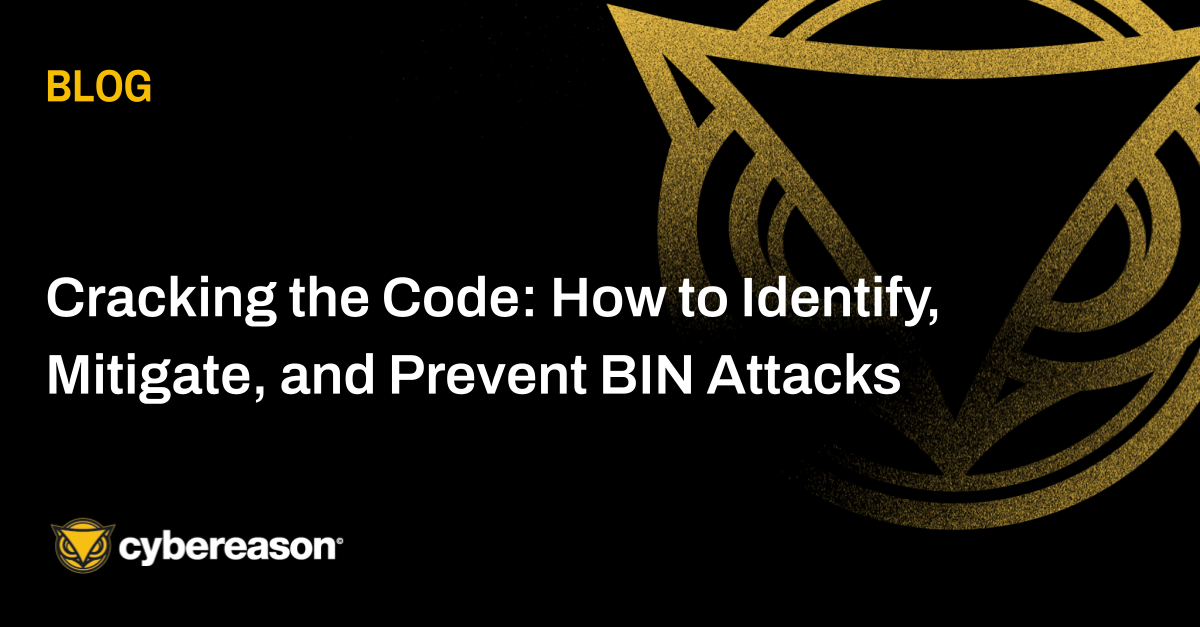
Cracking the Code: How to Identify, Mitigate, and Prevent BIN Attacks
Introducing the Security Configuration Snapshot, an innovative enhancement to traditional BEC investigations, helping to minimize impact of incidents.
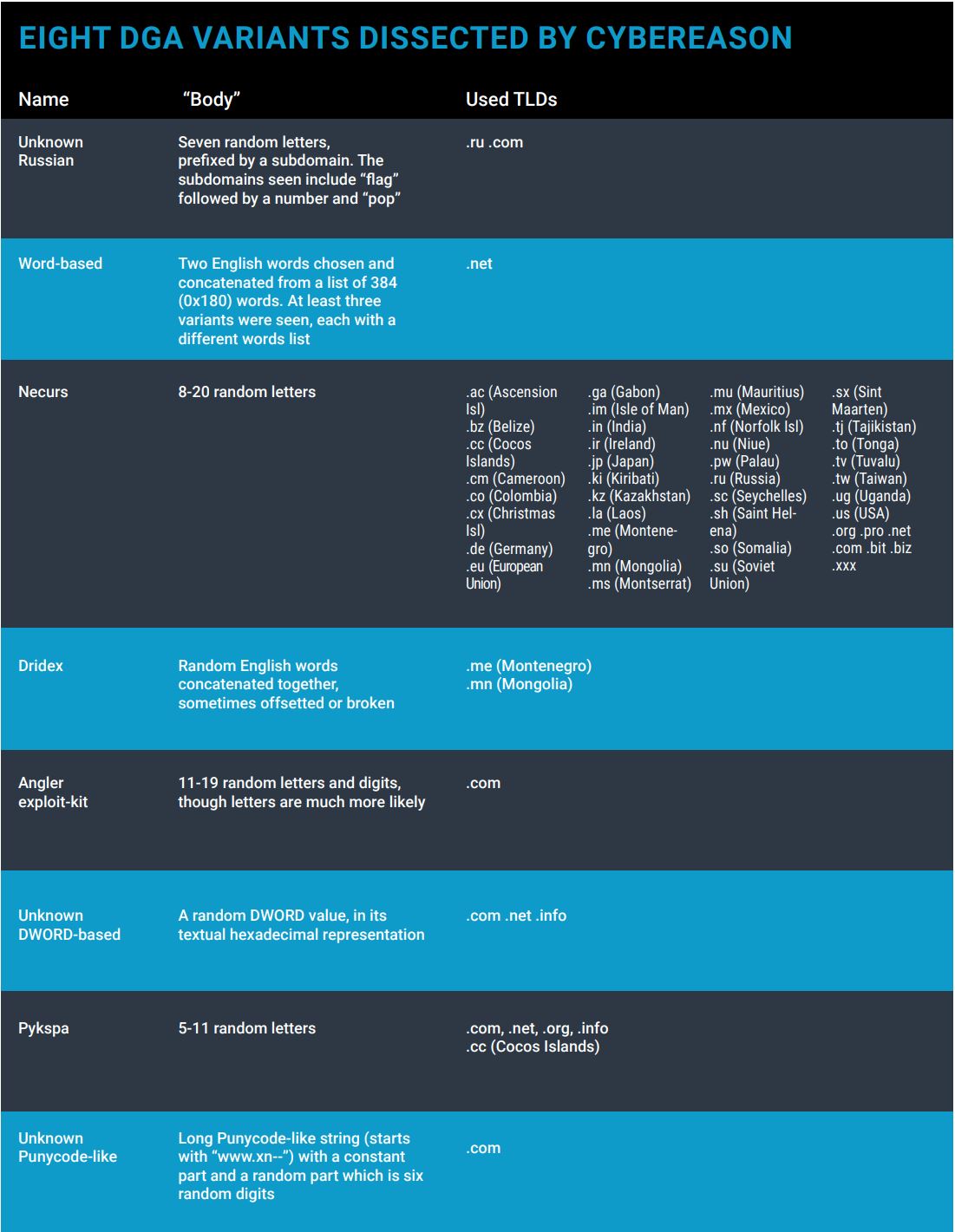
Lital Asher-Dotan
Even though attackers use various tools to compromise a network, there are core activities that form the foundation of each malicious operation.
One essential component is establishing command & control (C&C) communication between the attacker and hacked network. Detecting and blocking the attacker’s C&C attempts is a useful approach for shutting down a variety of malicious operations.
DGAs have quickly become the main method attackers use to remotely communicate with the sophisticated malicious tools they’ve created. Adversaries have stopped using hard-coded domain lists and IP addresses, which are useless once blocked. DGAs by comparison are easy to implement, difficult to block, and may be impossible to predict in advance and can be quickly modified if the previously used algorithm becomes known.
A DGA typically has three components:
A time-sensitive “seed”
A domain “body” generator that uses this seed
A set of top-level domains (TLDs)
Often, the seed is simply the current date in some standard format. The domain body generator is the main part of a DGA, and can basically be anything―a random string of characters, concatenation of random words, a constant part followed by a changing suffix, and so on. The set of TLDs, however, must contain real-world values that determine under which Web entities the generated domains are registered.
Even when a certain DGA is known (for example, by reverse engineering a malware sample), it’s still difficult―or even impossible―to effectively block it. First, there is the sheer number of possible domains that can be generated. Gameover Zeus, for example, generates 1,000 domains every day. This amounts to 365,000 domains that need to be generated in advance and blocked, which would strain on firewalls and other network-filtering solutions. And that’s just for one, single DGA for a year. While the amount of domains that need to be blocked is problematic and some registrars are very uncooperative with law enforcement agencies, the seed can be the real issue.
The date can be predicted indefinitely, but it’s not the only value that can constantly change. The DGA can use, for example, the daily trending hashtag on Twitter, the current exchange rate of the U.S. dollar to the Japanese yen, the temperature in Rio de Janeiro and basically any value that can be reliably obtained via the Internet by both the malware and its operator. Predicting these values in advance is of course impossible, and most filtering solutions do not support dynamic generation of domains to block.
Law enforcement and government agencies from across the world, including the FBI, have attempted to take control over these domains at the source by going after the registrars, as seen in Operation Tovar. But even government organizations have limits to their power.
In the case of Operation Tovar, the FBI, was unable to take over domains registered under the Russian TLD. And accessing the TLD name servers requires spending huge amounts of time and effort to obtain a warrant, which had to be renewed every six months.
Some researchers have tried to detect randomly-generated domains by their patterns, without knowing the algorithm in advance, and had some moderate success. The problem with this approach is two-fold. First, there is a strong chance for false positives, as many legitimate websites use load-balancing servers and other strange looking domain names, and the tiny ratio of DGA traffic compared to regular traffic makes false positives almost a certainty.
Secondly, DGA body generators can take many forms and aren’t necessarily a long string of random characters (see the following examples, detected in Cybereason customer environments). These domains can't be detected using traditional security methods.
The Cybereason platform uses a unique approach for DGA detection, looking for behaviors associated with DGAs instead of looking for DGA variants. Using this approach, Cybereason Labs has identified new DGA variants in customer environments. We hereby describe these variants and the outcome of our investigation.
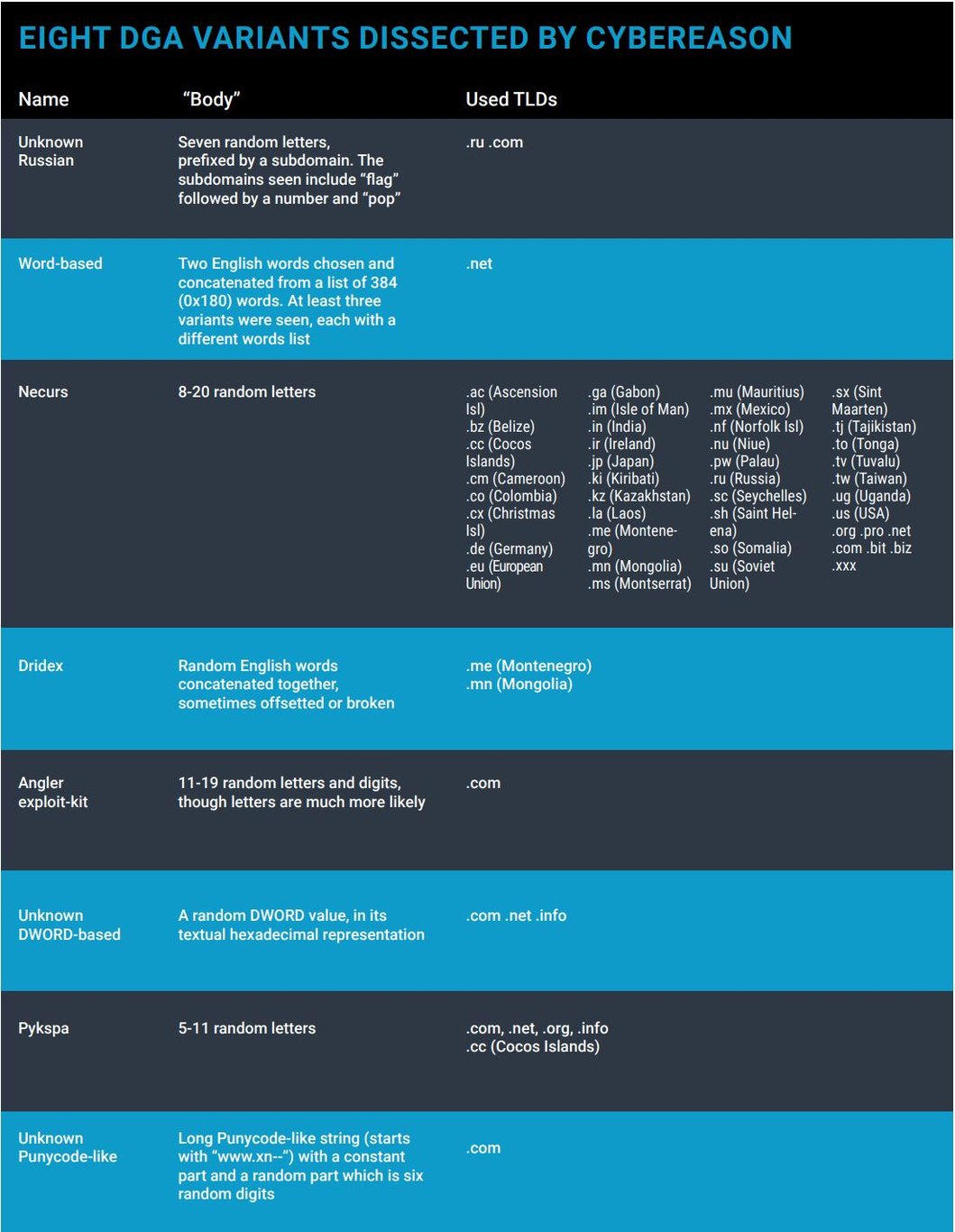
What is it?
A Russian malware using an unknown DGA. Mechanism of Action Each day, 35 domains are generated by randomly selecting seven letters, suffixing them with either the .ru or the .com top-level domains and prefixing them with the word “five” followed by a number. This is unusual, since most DGAs do not bother with any subdomain, and perhaps this is why it’s done in this case, to give some semblance of legitimacy. The malicious code usually injects itself into explorer.exe to evade detection.
The following is a screenshot of the detected DGA in a customer environment:
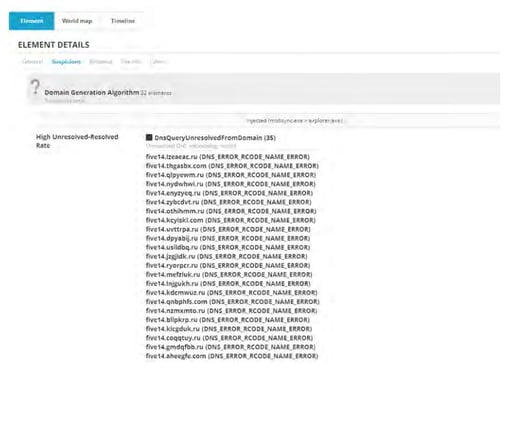 Another very similar variant was detected on another machine in the same organization, but in this case only nine domains are generated, and the prefix is the constant word “pop”: see the screenshot below.
Another very similar variant was detected on another machine in the same organization, but in this case only nine domains are generated, and the prefix is the constant word “pop”: see the screenshot below.
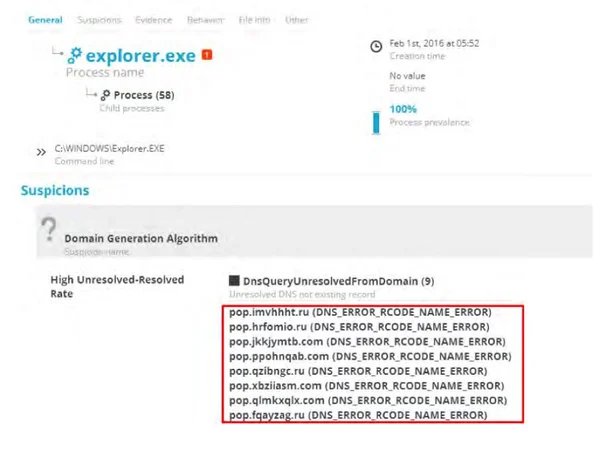
What is it?
This seems to be the same DGA as an unnamed malware analyzed by Crowdstrike in 2013. Mechanism of Action Domains are generated by randomly choosing two English words from a hard-coded list and concatenating them together under the .net top-level domain. With a list of 384 (0x180) words, this comes to approximately 150,000 possible combinations. The difficulty of detecting this simple algorithm is that the domains do not seem to be randomly generated, and the commonly used words may appear in many legitimate domain names. However, it seems that this malware may use several different word lists. By simply replacing this list, the attackers can completely evade detection of the old algorithm. This includes words such as “july,” “table,” “city,” “favor,” “dish” and others.
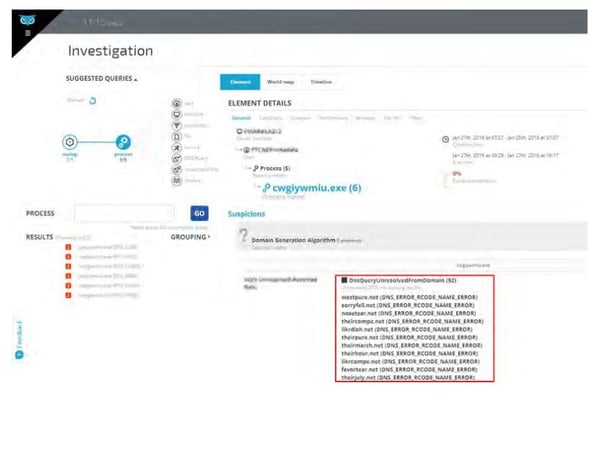
What is it?
A nasty backdoor malware. Mechanism of Action Randomly-generated strings of eight to 20 characters in length suffixed with one of the many multiple exotic top-level-domains, such as .ga (Gabon), .im (Isle of Man) and .sc (Seychelles). This makes it harder for law enforcement agencies to take down these domains.
The following are sample domains detected by Cybereason:
|
QUJFVNN.TO |
OLKQXMAEUIWYX.XXX |
|
CRWKBMX.TW |
BPWENCSDVRJXJI.PRO |
|
FFJVGCIF.MN |
SNDXKVGEFQQCFCTJ.PW |
|
JNHUTIIV.TV |
FQOXIBDVBYCNSAPPXC.NU |
|
YJENASPDAN.IN |
DOOKMSWEMEXLTBSUAL.SU |
|
AODXYTMXLB.COM |
OPCALVWELIIISUHXARKR.BIT |
What is it?
Dridex is a strain of banking malware that leverages macros in Microsoft Office to infect systems. What does it do? Concatenates English words and parts of words chosen in random from a small list, suffixed by the .mn (Mongolia) and .me (Montenegro) top-level domains. Unlike the malware described by Crowdstrike, in this variant the words are often broken, shifted and padded with random characters, significantly increasing the number of possible combinations and making detection much harder.
The following are sample domains detected by Cybereason:
CLIENTALALAXP.MN
CLIENTALNOTHING.ME
USERALCLICLIENT.ME
AGENTCLIENTCLIENT.ME
JSCJSCAXPCLIALLOW.ME
JSCCLIENTAGENTDISA.ME
DISAALALLOWDISALLOW.ME
ALLOWCLIENTAXPALAGENT.ME
CLIAGENTDISALLOWALLOW.ME
CLIALJSCNOTJCLIENTCLI.ME
What is it?
A widely used exploit kit.
Mechanism of Action
While the domains generated by this DGA were previously connected to the Angler exploit kit, they do not appear to be generated by the known DGA, and may be a new variant. The algorithms strings randomly chosen characters and digits under the .com top-level domain.
The following are sample domains detected by Cybereason:
| V6PNSC80LL.COM | JVRRMMKYEJDEYLCQ.COM |
| B9U5R3RJMPP.COM | LKLHJONIUDKKHCWO.COM |
| YM5R99EX5Q8.COM | CADDBSGSCNYDZOH5F.COM |
| MBSIGLGFQIH2.COM | CEUNNFOHGWJYAUA9H.COM |
| GSJZNQCOHIKO.COM | NQZHTFHRMYMTVBQJE.COM |
| VEG2671WMX88.COM | OVLREWGRHHVAJBOTX.COM |
| DLNOYYVQSOZHH.COM | OTPWFJOKPOZOOMNK2O.COM |
| BFZFLQEJOHXMQ.COM | CNEISZDKHZEKQEUBUT.COM |
| AJFSZWOMNHDFCYY.COM | EMUXMJDBTNWCQRFN0G.COM |
| EXAGQLXTMOPSFT8.COM | OWASALWIGURWYVNNPV.COM |
| FWOGZPAGLGOVLIMY.COM | PMNYPARTDBVYHCZDJS.COM |
What is it?
Unknown malware injected inside svchost.exe.
Mechanism of Action
The DGA of this malware seems to generate a random DWORD (a 32-bit integer, with a maximum value of approximately 4 million) then converts it to its hexadecimal format and suffix the result with either the .com, .net or .info TLDs. This DGA has not been disclosed before online, making it unique. This appears to be the first time this DGA has been discussed, making it a new discovery.
The following are sample domains detected by Cybereason:
04F645A5.COM 15AF64DD.INFO 2518F789.COM 2AF14345.INFO 39E076F7.INFO 3E0CA533.NET 428BF932.COM 4E32A34D.INFO 59D1FC99.NET 6CC69779.NET 78E05B8B.NET 7C7F4A6E.COM 974381F6.NET 9890D1FA.INFO B06CB4A1.NET C50A4E79.COM D3270391.NET D41FCED5.NET DB0311C2.INFO F7A1F33B.INFO
What is it?
A stealthy botnet that uses Skype. Mechanism of Action Randomly generated strings of characters of varying lengths suffixed with the .com, .net, .org, .info and .cc (Cocos Islands) top-level domains.
The following are sample domains detected by Cybereason:
CFAOBN.COM QQQCLQFO.CC HYEHGNR.NET SWGDOM.INFO FVGCWBMX.ORG HGZGHCYJ.NET USCNXQES.ORG GVMVMEQD.NET LEZBMAH.INFO IJDVHZYQS.NET JUKIULBI.INFO ASOOGYCRE.NET EYHKHBTPYG.NET PDOYVFIGFG.NET IXLMYGMNDWJ.CC CIJFTOCHT.INFO ATRAEAUZWUJ.ORG YRWRWYZSQL.INFO XGUGUSBBOK.INFO RZXFYIIXJOE.INFO
What is it?
Unknown malware that generates domains that look like Punycode―non-English domain names―but are, in fact, randomly-generated gibberish.
The following are sample domains detected by Cybereason:
WWW.XN--ZALGO003446-SJGB60AIGHL2I8JC3B0A2A97FTBLL0CZA.COM
WWW.XN--ZALGO012841-SJGB60AIGHL2I8JC3B0A2A97FTBLL0CZA.COM
WWW.XN--ZALGO029243-SJGB60AIGHL2I8JC3B0A2A97FTBLL0CZA.COM
WWW.XN--ZALGO075952-SJGB60AIGHL2I8JC3B0A2A97FTBLL0CZA.COM
Instead of trying to fight each DGA variant separately, a nearly impossible task, Cybereason concentrates on the ripples it leaves. We detect the technique, not the variant. And since no legitimate process will ever use DGA, just detecting it incriminates the process as malicious. This is a part of Cybereason's "Aikido approach": Using the opponent's strength against him/her. The more adversaries try to hide, the more suspicious they appear

Lital is a Marketing Team Leader, Storyteller, Technology Marketing Expert. She joined Cybereason as the first marketing hire and built a full marketing department. Specializing in brand building, product marketing, communication and content. Passionate about building ROI-driven marketing teams.

Introducing the Security Configuration Snapshot, an innovative enhancement to traditional BEC investigations, helping to minimize impact of incidents.

The Cyber Defenders Council is an independent group of preeminent cybersecurity leaders from public and private sector organizations around the world with the mission to adapt Defend Forward deterrence concepts for the private sector - read the inaugural report here...

Introducing the Security Configuration Snapshot, an innovative enhancement to traditional BEC investigations, helping to minimize impact of incidents.

The Cyber Defenders Council is an independent group of preeminent cybersecurity leaders from public and private sector organizations around the world with the mission to adapt Defend Forward deterrence concepts for the private sector - read the inaugural report here...
Get the latest research, expert insights, and security industry news.
Subscribe